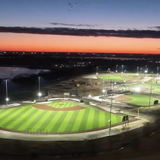Bruce Thummel (’06) is the HVAC technician serving Olin Hall. He knows the ins and outs of Olin’s heating and cooling systems better than anyone. And one of the cooling system’s “outs” has always bothered him: namely, the thousands of gallons of water it poured down the drain all summer long.
Evaporative Cooling System is Hard on the Chiller
Smith-Curtis and Olin Hall share a cooling system that pumps water in a loop between a chiller and a cooling tower. The system uses evaporative cooling—just like our bodies do. When our sweat evaporates, it draws heat away from our bodies. As the water in the cooling tower evaporates, the salts and minerals remain—just like the salt on your face after a good workout.
“So the mineral content in the remaining water increases. That’s hard on the chiller,” Thummel said, “so you have to treat it and eventually get rid of it. On a really hot day, the chiller will throw off about 2,000 gallons,” he said.
Could Discarded Water be Reused?
The 2012 drought killed much of the grass near Olin. Thummel wondered whether the discarded water from the cooling tower could be used to irrigate that area in the hottest, driest months. Would the mineral content in the water be too high to sustain grass?
He found articles that said such systems worked fine. Others said it would only kill your lawn. And others came in between, saying the water could be used so long as it was properly diluted. “But nothing I read was academic,” he said.
What do you do when you’re in Olin Hall of Science and can’t find a scientific study? You build one.
Thummel Turns to Physics Department for Help
Thummel turned to his faculty colleagues, looking for a student to help run a study for credit on the impact this irrigation system would have on soil. Professor of Physics Bob Fairchild connected Thummel with Brock Taute, a junior physics major from Bertrand, Neb.
They took initial soil samples to establish a baseline, and then more throughout a summer of watering. They followed up in the fall and winter to determine how the rain and snow naturally deplete the mineral buildup after a summer’s watering.
“We’ll probably need a year or two to get the data we need to make an informed decision,” Thummel said. He said multiyear data are necessary because if the mineral levels don’t deplete over the fall, winter and spring at the necessary rate, they could have a scenario where the system seems to work well for a few years only to have the mineral content slowly accumulate to unwanted levels. So they’re being patient.
Results Could Mean Lower Water Bills
If their study shows it’s feasible, the system could then be replicated in the Rogers Center for the Fine Arts. “I’m guessing we could get half the water needs for the west half of campus from these systems,” Thummel said. The end result could be greener grass all over campus and lower water bills.











